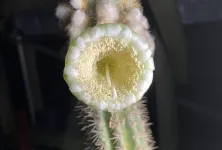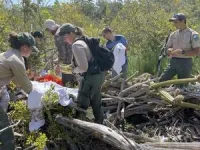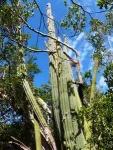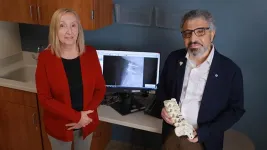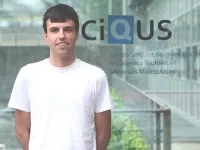(Press-News.org) The United States has lost its only stand of the massive Key Largo tree cactus in what researchers believe is the first local extinction of a species caused by sea level rise in the country.
The Key Largo tree cactus (Pilosocereus millspaughii) still grows on a few scattered islands in the Caribbean, including northern Cuba and parts of the Bahamas. In the United States, it was restricted to a single population in the Florida Keys, first discovered in 1992 and monitored intermittently since.
Salt water intrusion from rising seas, soil depletion from hurricanes and high tides, and herbivory by mammals had put significant pressure on the population. By 2021, what had been a thriving stand of about 150 stems was reduced to six ailing fragments, which researchers salvaged for off-site cultivation to ensure their survival.
“Unfortunately, the Key Largo tree cactus may be a bellwether for how other low-lying coastal plants will respond to climate change,” said Jennifer Possley, director of regional conservation at Fairchild Tropical Botanic Garden and lead author on a study published Tuesday, July 9 that documents the population’s decline.
Two closely related cacti negatively affected by environmental change
Comparatively little is known about Florida’s rare cacti. Researchers initially stumbled upon the Key Largo tree cactus in an isolated mangrove forest, and for several years afterward, its identity remained uncertain. Most considered it to be a unique population of the similarly named Key tree cactus (Pilosocereus robinii), a federally endangered species that is present elsewhere in the Florida Keys.
The two cacti have a similar appearance. The stems of both shoot up perpendicular to the ground and can grow to be more than 20 feet tall. Both have cream-colored flowers that smell like garlic and reflect moonlight, attracting bat pollinators, while their bright red and purple fruit catch the eye of birds and mammals.
But there are key differences as well, which made Alan Franck, currently the herbarium collection manager at the Florida Museum of Natural History, suspect they were dealing with something unique on Key Largo.
“The most striking difference is the tuft of long, woolly hairs at the base of the flowers and fruits,” Franck said. The hair is so thick, it can look as though the cactus is covered in drifts of snow. Spines of the Key Largo cactus are also twice as long as they are on the Key tree cactus.
In 2019, Franck confirmed that the Key Largo population was the first and only known instance of Pilosocereus millspaughii in the U.S.
By then, it was succumbing to some of the same environmental pressures that had plagued its relative, the Key tree cactus, over the last century. The latter was once common throughout the Florida Keys, but its numbers dipped dangerously low as more people moved to the area.
Writing in 1917, botanist John Small noted that the Key tree cactus “was for a long time very abundant [on Key West]…In recent years, with the destruction of the hammock for securing firewood and for developing building sites, this interesting cactus has become scarce, until at present it is on the verge of extermination in its natural habitat.”
The Key tree cactus was listed as federally endangered in 1984, but its numbers continued to wane. Between 1994 and 2007, it decreased by 84%.
Researchers at Fairchild began monitoring all of the tree cactus populations annually in 2007, working in tandem with local land managers. One Fairchild-led study showed that salt levels were higher in soil beneath dead vs. living cacti in the years following a storm surge event in the Lower Keys, drawing a clear connection between mortality and increased salinity.
Researchers also initiated a robust conservation collection for these species. Potted cacti are grown at a facility in Coral Gables, Florida, and seeds from both wild and cultivated plants are carefully banked for long-term conservation.
Researchers study and rescue the remnants of a dwindling stock
The Key Largo tree cactus grew on a low limestone outcrop surrounded by mangroves near the shore. The site originally had a distinct layer of soil and organic matter that allowed the cactus and other plants to grow, but storm surge from hurricanes and exceptionally high tides eroded away this material until there wasn’t much left.
Salt-tolerant plants that had been previously restricted to brackish soils beneath the mangroves slowly began creeping up the outcrop, an indication that salt levels were increasing.
Given enough time, these changing conditions would likely have killed the cactus. But other incidents occurred that hastened the pace.
“We noticed the first big problem in 2015,” said study co-author James Lange, a research botanist at Fairchild. When he and his colleagues arrived to evaluate the plants that year, half of the cacti had died, apparently as a result of an alarming amount of herbivory. Cacti store reserves of water in their succulent stems, which allows them to survive for long periods of time without rain. This makes them enticing to animals when other sources of water are scarce.
“In 2011, we started seeing saltwater flooding from king tides in the area,” Lange said, referring to particularly high ocean tides. “That limits the amount of freshwater available to small mammals and might be related to why the herbivores targeted this cactus, but we can’t say for sure. We’d never seen cactus herbivory like this anywhere in the Lower Keys, where flooding has tended to be less extensive.”
The team set out cameras in hopes of finding the culprit, but whatever it was did not return, and there was no evidence of significant herbivory thereafter. Yet, when the team came back the following year, roughly another 50% of the population had died. In response, staff from Fairchild and the Florida Department of Environmental Protection took a few cuttings of what remained to grow in greenhouses.
In 2017, category 5 Hurricane Irma swept across South Florida, creating a 5-foot storm surge. The highest point on Key Largo is only 15 feet above sea level, and large portions of the island remained flooded for days afterward. Once the storm had passed, the Fairchild team conducted triage with several cactus populations throughout the Keys, removing branches that had fallen on cacti and salvaging other ill-fated material. Conditions were so extreme that biologists had to put out kiddie pools of freshwater to keep local wildlife alive.
Exacerbating the already degrading Key Largo tree cactus habitat, king tides in 2019 left large portions of the island, including the extremely low-lying outcrop, flooded for over three months.
By 2021, there were only six Key Largo tree cactus stems left. As it was clear the population wasn’t going to survive, the team allowed the plants to flower and fruit for the remainder of the year, then salvaged all remaining green material and replanted it in greenhouses or controlled settings outdoors. At present, researchers know of no naturally growing Key Largo cacti in the United States.
“We have tentative plans with the Florida Department of Environmental Protection to replant some in the wild,” Possley said.
Similar efforts are responsible, in large part, for the continued existence of the related Key tree cactus in Florida. “The amount of reintroduced material of this species is already more than the amount of wild material that’s left,” Possley said.
But, she added, this may end up being more of a stopgap than a solution. Environments suitable for tree cacti are disappearing along with the plants they support. “It’s generally a fringe between the mangroves and upland hammocks called thorn scrub, and there just aren’t many places like that left where we can put reintroduced populations.”
The decline of the Key Largo tree cactus and the necessity of its removal has given researchers an idea of what to expect in the future as species contend with a rapidly warming world. Instead of a smooth, predictable rise in sea or salt levels, the reality of climate change is messier and manifests itself in a complex series of related events that put additional pressure on species that are already stressed.
“We are on the front lines of biodiversity loss,” said study co-author George Gann, executive director for the Institute for Regional Conservation. “Our research in South Florida over the past 25 years shows that more than one-in-four native plant species are critically threatened with regional extinction or are already extirpated due to habitat loss, over collecting, invasive species and other drivers of degradation. More than 50 are already gone, including four global extinctions.”
The authors published their study in the Journal of the Botanical Research Institute of Texas.
END
First local extinction in the US due to sea level rise
2024-07-09
ELSE PRESS RELEASES FROM THIS DATE:
Empowering Ugandan female youth with self-esteem, self-efficacy, and gratitude using Transcendental Meditation
2024-07-09
A peer-reviewed study published today in Health Care for Women International found that the Transcendental Meditation® (TM®) technique can empower the lives of female youth living under conditions of poverty in the city slums of Kampala, Uganda. Outcomes include increased self-esteem, self-efficacy, and gratitude; and decreased tiredness, worry, and excessive alcohol use. TM helped these young women improve their mental and physical health, as well as their relations with family and community members.
“The ...
Brian Wachtel is promoted to Chief Development Officer at NFCR
2024-07-09
The National Foundation for Cancer Research (NFCR) proudly announces the promotion of Brian Wachtel to Chief Development Officer. Brian will continue his responsibilities as the Executive Director, and his expanded role will further enhance his leadership within the organization.
Brian joined the National Foundation for Cancer Research in September 2016 as the Director of Corporate Partnerships & Special Events. In that capacity, he was in charge of organizing and expanding NFCR’s community outreach events. One of his important ...
Digital self-harm surges among U.S. teens from 2016 to 2021
2024-07-09
Adolescents worldwide have embraced social media and online platforms for self-expression and to explore their identity. This freedom, however, can lead to risky behaviors, especially with limited adult supervision. For example, digital self-harm is a recent, emerging trend where individuals anonymously post or share hurtful content about themselves online. This behavior can be mistaken for mistreatment by others, yet the perpetrator and victim are the same person.
First identified in 2010, digital self-harm has not received the same amount of scholarly scrutiny as other forms of self-directed abuse and has not been widely addressed by adults ...
UTSA joins new consortium dedicated to nuclear security and nonproliferation
2024-07-09
The University of Texas at San Antonio (UTSA) has joined one of two newly established university consortia committed to nuclear security and nonproliferation. The consortia were awarded $50 million in cooperative agreements by the Office of Defense Nuclear Nonproliferation in the U.S. Department of Energy’s National Nuclear Security Administration (DOE NNSA).
“The pressing challenges of nuclear security and nonproliferation require a concerted effort from experts across the country,” said JoAnn Browning, UTSA interim vice president for research. ...
Diabetes increases the risk of failure in spinal fusion procedures
2024-07-09
A new study from orthopaedic researchers at The University of Toledo has found lumbar spinal fusion procedures are far more likely to fail in individuals with diabetes.
“We’ve known for a long time that diabetic patients are at high risk of infection from any surgery, including spinal fusion,” said Dr. Hossein Elgafy, a professor of orthopaedics in the College of Medicine and Life Sciences and chief of spine surgery at UTMC. “More recently, however, physicians have taken a closer look at the high ...
Brain-computer interface therapy for stroke survivors
2024-07-09
A personalized brain-computer interface therapy, RehabSwift, significantly enhances hand mobility for stroke survivors. Strokes often lead to impaired hand function, presenting substantial challenges in daily activities. Sam Darvishi and colleagues developed and tested a brain-computer interface therapy that translates imagined hand movements into real actions using a personalized algorithm and bionic hands. The study involved twelve chronic stroke survivors from South Australia who had limited use of their arms but retained clear thinking abilities. Throughout 18 sessions, participants used the RehabSwift system, which included a special cap that ...
SynGAP Research Fund (SRF) increases support for SYNGAP1 organoid research at the University of Southern California’s Quadrato Lab
2024-07-09
MILL VALLEY, Calif. – July 9, 2024 – SynGAP Research Fund (SRF), a 501(c)(3) public charity whose mission is to improve the quality of life for patients suffering from SYNGAP1-Related Disorders (SRD) through the research and development of treatments, therapies, and support systems, has awarded a $130,000 grant to the University of Southern California’s Quadrato Lab to inspect and stratify the effects of specific SYNGAP1 variants on their patient-derived neuronal model system, furthering the world’s understanding ...
Study finds 1 in 12 patients labeled as having ‘benign’ results actually had high-risk prostate cancer
2024-07-09
New research highlights the challenge of balancing the risks of overdiagnosing and underdiagnosing prostate cancer early enough to intervene and minimize risk of death. Recently, some experts have called for the lowest grade of prostate cancer—biopsy Gleason Grade Group (GGG) 1—to be reclassified as ‘benign.’ But a new study led by a researcher from Mass General Brigham has found that many patients with a biopsy GGG1 may have a more aggressive cancer than their biopsy alone suggests.
By looking at data from more than 10,000 patients at a university in Germany, researchers found that at least 8 percent of patients with this ...
Marcos Vilela wins Lilly Research Award for Doctoral Students
2024-07-09
The Royal Spanish Society of Chemistry (RSEQ) and Lilly have announced the winning theses of the 22nd Research Awards for Doctoral Students, which acknowledge outstanding work in the fields of Organic, Pharmaceutical, and Analytical Chemistry. Marcos Vilela, currently pursuing his PhD at the Center for Research in Biological Chemistry and Molecular Materials (CiQUS) at the University of Santiago de Compostela (USC), was awarded alongside Andrea Palone from the University of Girona (UdG) and the University of Rome "Tor Vergata," and Beatriz Arévalo from the Complutense University of Madrid (UCM).
Marcos' thesis, supervised by CiQUS Principal ...
Trust, more than knowledge, critical for acceptance of fully autonomous vehicles
2024-07-09
PULLMAN, Wash. – While not yet on the market, fully autonomous vehicles are promoted as a way to make road travel dramatically safer, but a recent study found that knowing more about them did not improve people’s perception of their risk. They needed to have more trust in them too.
This study adds to the evidence from other research that knowledge alone is not enough to sway people’s attitudes toward complex technology and science, such as gene editing or climate change. In this case, Washington State University researchers found that trust in the autonomous vehicles’ reliability and performance played the strongest role in improving ...
